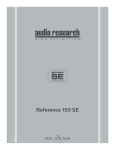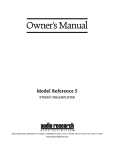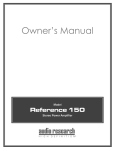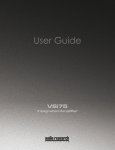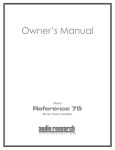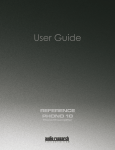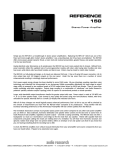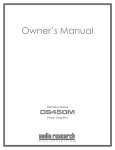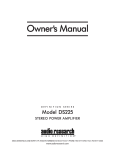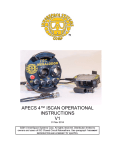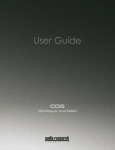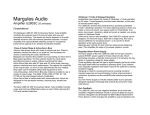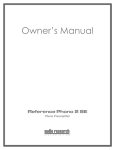Download Reference 75 SE Manual Stereo Power Amplifier
Transcript
H I G H D E F I N I T I O N® Reference 75 SE Thank you for choosing the Reference 75 SE to be a part of your high performance music listening system. Since 1970, Audio Research has been creating some of the world’s finest audio equipment. Each piece is handcrafted in Minnesota, and has been designed to provide many years of listening enjoyment. We understand you are eager to begin listening; however, please take a few minutes to read through this guide for useful information concerning the operation of your new amplifier. Once installed, please allow an appropriate breakin period to fully appreciate the benefits this amplifier will provide to your system. After reading the user guide, if you have any further questions regarding your amplifier, contact your dealer or Audio Research customer service - they will be happy to help you make the most of your new component. Happy Listening! Thank You. Contents Warnings 5 Installation Before Operating the Reference 75 SE In Your System 6 Connections Back Panel Controls and Connections Input Connectors Output Connectors Matching Remote Turn-on A.C. Power Connection 7 8 9 9 9 10 11 12 13 13 13 13 14 Maintenance Vacuum Tubes Service Cleaning Disposal and Recycling Guidelines 15 15 15 15 Warranty 16 Specifications 17 4 Operation Front Panel Controls and Displays Start-Up Shut-Down Break-in Display Brightness Adjustment Output Tube Bias Adjust Warnings To prevent fire, or shock hazard, do not expose your Reference 75 SE to rain or moisture. For continued protection against fire hazard, replace the fuse only with the same type and rating as specified at the fuse holder. Do not place objects containing water on top of this unit. This unit is RoHS compliant. A note about packaging... This unit contains voltages which can cause Save all packaging in a dry place away from serious injury or death. Do not operate fire hazard. Your Reference 75 SE amplifier with covers removed. Refer servicing is a precision electronic instrument to your authorized Audio Research and should be properly cartoned any dealer or other qualified personnel. time shipment is made. You may not have occasion to return your unit to the The detachable power cord on your factory for service, but if that should Reference 75 SE is equipped with a heavy prove necessary, or other occasion gauge, 3-conductor cable and a standard requiring shipment occurs, the original three-prong grounding plug. For absolute packaging will protect your Reference 75 protection, do not defeat the ground power SE from unnecessary damage or delay. plug. This provides power line grounding of the Reference 75 SE chassis to provide absolute protection from electrical shock. The appliance coupler (a.c. power connector) at the rear of this unit must be accessible for emergency power disconnect. 5 Installation REAR 4 KT150 V2 V4 V1 V3 2 6H30 V5 V6 TUBE LOCATIONS TOP VIEW FRONT Before operating the Reference 75 SE Remove all screws fastening the top cover. Your Reference 75 SE amplifier is shipped Carefully remove each vacuum tube with the vacuum tubes packed in foam from its protective foam and match its blocks. These must be unpacked and location ‘V’ number (written on the base installed before you attempt to operate the of the tube) to the ‘V’ number printed amplifier. Included are two matched pair next to each socket. Firmly seat each of KT150 output tubes, and two 6H30 dual tube in its matching socket, taking care triodes used in the input stage. Proceed to ‘key’ the tube pins to the socket holes. according to the following instructions. Retain the foam blocks with other packing materials for possible future use. Refasten top cover on amplifier. 6 Installation In your system To insure normal component life and safe operation this unit must be operated only in an upright position. Adequate airflow and proper cooling can occur only if there is no restriction above and behind the unit and on either side. The ‘ambient’ operating temperature should never exceed 120° F or 49° C. Improper installation will cause premature tube failure and will affect your warranty, as well as the service life of the unit. It is normal for a vacuum tube power amplifier to run quite warm, and if used for prolonged periods, hot to the touch. All components within are, however, operated at safe, conservative levels and will not be improperly affected thereby, providing the requirements outlined above are adhered to. The special non-marring elastomer feet provide adequate spacing and stability only on a smooth, hard surface, and also assist to isolate the amplifier from spurious vibrations. For upright stability and best performance, never operate the unit while it is sitting on a soft surface such as a thick rug or carpet. Due to its weight, this amplifier must be supported on a surface specifically rated for such a load. Check with the manufacturer of your support system to be sure it is rated to handle this weight. If the unit is to be operated in an enclosure such as an equipment rack, make certain that adequate airflow above and to each side of the unit is provided. 7 Connections Back Panel Controls and Connections Left and Right XLR inputs 12V remote trigger Meter Lights on/off REFERENCE 75 STEREO AMPLIFIER PLYMOUTH, MINNESOTA MADE IN U.S.A. RIGHT INPUT LEFT INPUT METER LIGHTS ON WARNING CAUTION TO PREVENT FIRE AND SHOCK HAZARD, DO NOT EXPOSE THIS DEVICE TO RAIN OR MOISTURE. UNIT MUST BE OPERATED IN A HORIZONTAL POSITION. ! RISK OF ELECTRIC SHOCK DO NOT OPEN OFF -DO NOT OPERATE WITH COVERS REMOVEDUNIT CONTAINS VOLTAGES WHICH MAY BE HAZARDOUS. IN OUT +12V REMOTE TURN ON CAUTION WARNING RISK OF HAZARDOUS ENERGY! MAKE PROPER SPEAKER CONNECTIONS SEE OWNERS MANUAL FOR CONTINUED PROTECTION AGAINST FIRE HAZARD REPLACE FUSE ONLY WITH SAME TYPE AND RATING 5A FUSE SLO-BLO T4A (230V) VOLTS WARNING RISK OF HAZARDOUS ENERGY! MAKE PROPER SPEAKER CONNECTIONS SEE OWNERS MANUAL SERIAL 0 4 8 500W MAX 50/60 HZ ~ Fuse holder A.C. Mains connector Speaker connections 8 0 4 8 Connections Input Connectors The Reference 75 SE uses a fully balanced circuit topology and has a pair of balanced XLR input connectors on the rear panel. It therefore requires a balanced preamplifier output, as provided by most Audio Research preamplifiers. Connect your preamplifier’s output to the Reference 75 SE before turning on the amplifier. Important Use the best available speaker wires and interconnects. Audio Research cannot emphasize this enough. As better components and systems are developed, it becomes increasingly important to avoid the limitations of inferior system interconnections. It is important sonically that your entire system be connected so that the audio signal arriving at the speakers has correct, or ‘absolute’ polarity (i.e., noninverted). Connect the black or ‘–‘ speaker terminal to the wire that connects to the ‘0’ terminal on the Reference 75 SE. Connect the red or ‘+’ speaker terminal to the wire that connects to the ‘4’ or ‘8’ terminal on the Reference 75 SE and tighten the speaker terminals securely to ensure best sonic results. Output Connectors Heavy-duty output terminals are provided on the rear panel for 4 or 8-ohm speaker impedance loads. Using high-quality speaker cables, securely fasten the (-) speaker lead to the appropriate (black) terminal, then the (+) lead to the matching (red) terminal. Follow your speaker manufacturer’s impedance specification. The Reference 75 SE puts out the same amount of power whether the 4 or 8-ohm terminals are used. Matching It is important to use as close as possible an impedance match between the amplifier and speaker for optimum transfer of power to the speaker with minimum distortion. In the case of speaker systems with significant variations in impedance throughout the frequency spectrum, such as most electrostatic types, determine the best impedance match empirically for best overall sonic results. Connect the Reference 75 SE input to the preamplifier or electronic crossover, using only the highest grade of audio interconnect cables. To avoid sonic degradation use the shortest practical length of cables. 9 Connections Remote Turn-on The Reference 75 SE has a built-in 12V DC remote turn-on/off circuit for operation by a master control system in a home theater or large audio system. Use a 3.5mm (.140”) diameter mono mini plug to connect to the +12V IN jack on the rear of the Reference 75 SE. The +12V IN jack should be connected to the +12V DC output of the master control system, using a continuous +12V DC signal at 12mA per Reference 75 SE for the duration of amplifier on-time. Do not use a momentary or data pulse control signal. The +12V DC remote jacks have polarity protection, so they will not operate if a -12V DC signal is accidentally connected, or if the control wires are reversed. When the 12V DC remote turn-on/off circuit is used, the power switch on the front panel should be turned off. 10 Connections A.C. Power Connection It is important that the Reference 75 SE be connected via its supplied 20 amp IEC 12-gauge power cord to a secure, dedicated A.C. power receptacle. Never connect to convenience power receptacles on other equipment. Only use the power switch on the front of the Reference 75 SE for On/ Off control of the amplifier, or the 12V start-up trigger for remote installations. The Reference 75 SE uses a grounding system that does not require a ground-lifter adapter plug on the A.C. power cord to minimize hum. The power cord supplied with the Reference 75 SE has a standard grounding plug to provide maximum safety when properly connected to a grounded wall receptacle. If there is any question regarding proper grounding procedures in your installation, seek help from a qualified technician. Caution should be taken before using custom after-market power cords: they must be at least 12-gauge and have a standard grounding plug properly installed. These power cords are to be used with caution, at the sole risk of the owner. The AC power source for the Reference 75 SE amplifier should be capable of supplying 10 amperes for 100 or 120 volt units, or 5 amperes for 220 or 240 volt units. For the very best performance on 100 or 120 volt circuits, the Reference 75 SE should be connected to its own AC If electronic crossovers or other AC powered power circuit branch, protected by a 15 equipment is used with the Reference amp breaker. The preamplifier and other 75 SE it may be necessary to use ‘ground audio equipment should be connected lifter’ adapters on the power plugs of to a different power circuit and breaker. that equipment to minimize system The Reference 75 SE should be turned hum. Generally, the lowest hum is on after the other components of your achieved when the only direct connection system. If the Reference 75 SE is turned on between audio common ‘ground’ and true before other components, the amplifier earth ground occurs in the preamplifier, will amplify any extraneous turn-on noises through its grounded power cord. those components might generate, which Other equipment in the system should could potentially damage the loudspeakers. have some form of isolation to prevent Good operating practice dictates that ground loops and associated hum. the amplifier should be turned on last, and turned off first in an audio system. 11 Operation Front Panel Controls and Displays Power output and bias meters POWER OUTPUT LEFT POWER OUTPUT RIGHT OPERATE OPERATE OPERATE BIAS V1 OPERATE BIAS V2 BIAS V3 BIAS V4 POWER VACUUM TUBE POWER AMPLIFIER REFERENCE 75 HIGH DEFINITION Main Power Switch Bias/Operate Switches 12 R Operation Start-Up •Secure interconnects between the amplifier and your preamplifier; attach speaker leads to the appropriate output terminals. •Attach supplied power cord to rear IEC inlet of amplifier, and plug other end into grounded A.C. power receptacle. •Turn on preamp and all other components; mute preamp output. •Press Reference 75 SE front panel control switch. Green power LED will light. •Unmute preamplifier output, initiate source component signal, and adjust gain as appropriate. Break-in All quality stereo equipment benefits from a break-in period; during this time, the various components, wiring and solder connections change as electrical signals pass through them. While your Reference 75 SE will sound fantastic out of the box, it will only improve with continued use. Display Illumination The front panel meter display is illuminated with ultra low-noise, low voltage LED lighting which has no impact on sound quality when turned on. The display illumination can be turned on or off. To change the brightness of the display, locate the switch on the back panel labeled ‘Meter Lights’. Select the on or off position. Shut-Down •Mute preamplifier output. •Switch Reference 75 SE front panel control switch to off. •Turn off preamplifier and then the associated input source components. Important! After the Reference 75 SE is turned off, wait at least five minutes before turning it on again. This allows the large bank of storage capacitors to drain energy. Not allowing enough time for this process can result in blown fuses or other damage to your amplifier. 13 Operation Output Tube Bias Adjustment As shipped from the factory, the output ‘bias’ adjustments are set for a nominal 65mA per KT150 tube. Under these idle conditions the tubes are each dissipating approximately 27 watts of their 60 watt rating. This point of operation provides ‘enriched’ Class AB1, and will satisfy the most critical listener. For best results, operate and adjust the Reference 75 at 117.5 VAC (230 VAC). Adjustment must be made under zero-signal conditions after at least 15-20 minutes of uninterrupted stabilization time. With the amplifier warmed up and signal set to zero, switch the rotary knob to one of the ‘V’ settings. Insert only the supplied non-conductive bias adjustment tool into the appropriate bias adjustment holes. Slowly turn the bias adjustment potentiometer in each of the holes marked with the output tube ‘V’ number position only when the bias switch is set to that associated ‘V’ number position. The meter should be set to read in the center of the tube bias arc (@65mA) for each of the four output tubes V1 – V4 for optimum sonic performance. 14 Maintenance Vacuum Tubes It is recommended that you replace the vacuum tubes of your Reference 75 SE in sets. All of the tubes in your amplifier have been matched to have similar operating characteristics, to provide the best sound quality and reliability. In the event you need to replace a single output tube, please refer to the numbers written on the silver base at the bottom of the vacuum tube when ordering a new tube. Cleaning To maintain the new appearance of this amplifier, occasionally wipe the front panel and top cover with a soft, damp (not wet) cloth to remove dust. A mild, non-alkaline soap solution may be used to remove fingerprints or similar smudges. Cleaners containing abrasives should not be used as they will damage the anodized finish of the front panel. A small, soft paintbrush is effective in removing dust from bevels, the recessed nameplate and other features of the front panel. Servicing Because of its careful design and exacting standards of manufacture, your Reference 75 SE amplifier should normally require only minimal service to maintain its high level of performance. Disposal and Recycling Guidelines To dispose of this electronic product, do not place in landfill. In accordance with the European Union Waste Electrical and Electronic Equipment Caution (WEEE) directive effective August 2005, Your Reference 75 SE amplifier contains this product may contain regulated sufficient levels of voltage and current to materials which upon disposal require be lethal. Do not tamper with a component special reuse and recycling processing. or part inside the unit. Even with the power Please contact your dealer or importing turned off, a charge remains in the energy distributor for instructions on proper storage capacitors for some time. Refer any disposal of this product in your country. needed service to your authorized Audio Or, contact Audio Research Corporation Research dealer or other (763.577.9700) for the name of your qualified technician. Additional questions importing distributor and how to contact regarding the operation, maintenance or them. Packing and shipping materials servicing of your amplifier, please contact may be disposed of in a normal manner. the Customer Support Department of Audio Research Corporation at [email protected] or call 763-577-9700. You may also initiate a service request by visiting the Audio Research website (www.audioresearch.com) and selecting ‘Service Repair’ at the top right of the home page. 15 Warranty Audio Research Corporation products are covered by a 3-Year Limited Warranty or a 90-Day Limited Warranty (vacuum tubes). This Limited Warranty initiates from the date of purchase, and is limited to the original purchaser, or in the case of demonstration equipment, limited to the balance of warranty remaining after original shipment to the retailer or importer. In the United States, the specific terms, conditions and remedies for fulfillment of this Limited Warranty are listed on the warranty card accompanying the product in its shipping carton. The warranty terms are also available on the internet at www.audioresearch.com/ en-us/company/warranty-statement. Outside the United States, the authorized importing retailer or distributor has accepted the responsibility for warranty of Audio Research products sold by them. The specific terms and remedies for fulfillment of the Limited Warranty may vary from country to country. Warranty service should normally be obtained from the importing retailer or distributor from whom the product was purchased. In the unlikely event that technical service beyond the ability of the importer is required, Audio Research will fulfill the terms and conditions of the Limited Warranty. Such product must be returned at the purchaser’s expense to the Audio Research factory, along with a photocopy of the dated purchase receipt for the product, a written description of the problem(s) encountered, and any information necessary for return shipment. The cost of return shipment is the responsibility of the purchaser. 16 Specifications Power Output: 75 watts per channel continuous from20Hz to 20kHz. 1kHz total harmonic distortion typically 0.6% at 75 watts, below 0.05% at 1 watt. Approximate actual power available at ‘clipping’ 76 watts (1kHz). (Note that actual power output is dependent upon both line voltage and ‘condition’ i. e.: if power line has high distortion, maximum power will be affected adversely, although from a listening standpoint this is not very critical) Overall Negative Feedback: 15dB Slew Rate: 10 volts/microsecond Rise Time: 4.0 microseconds Hum & Noise: Less than 0.06mV RMS – 112dB below rated output (IHF weighted, input shorted) Power Supply Energy Storage: Approximately 520 joules Power Bandwidth: (-3dB points) 7Hz to 60kHz Power Requirements: 105-125VAC 60Hz (210-250VAC 50Hz) 410 watts at rated output, 500 watts maximum, 230 watts idle Frequency Response: (-3dB points at 1 watt) 0.7Hz to 75 kHz Input Sensitivity: 1.4V RMS BAL for rated output. (25 dB Bal gain into 8 ohms) Tubes Required: 2 – Matched pair KT150 – Power Output 2 – 6H30 Driver Input Impedance: 300K ohms Balanced Output Taps: 8 ohms, 4 ohms Dimensions: width 19” (48.3 cm) height 8.75” (22.2 cm) depth 19.5” (49.5 cm) Handles extend 1.5” (3.8 cm) forward Output Regulation: Approximately 1.0dB 8 ohm load to open circuit (Damping factor approximately 8) Weight: 47 lbs. (21.3 kg) Net 63 lbs. (28.6 kg) Shipping Output Polarity: Non-inverting. Balanced input pin 2+ (IEC-268) 17 H I G H D E F I N I T I O N® 3900 Annapolis Lane North Plymouth, MN 55447 www.audioresearch.com Specifications subject to change without notice. ©2015 Audio Research Corporation. Reproduction of this document in part or whole is expressly forbidden without written consent from Audio Research Corporation.


















